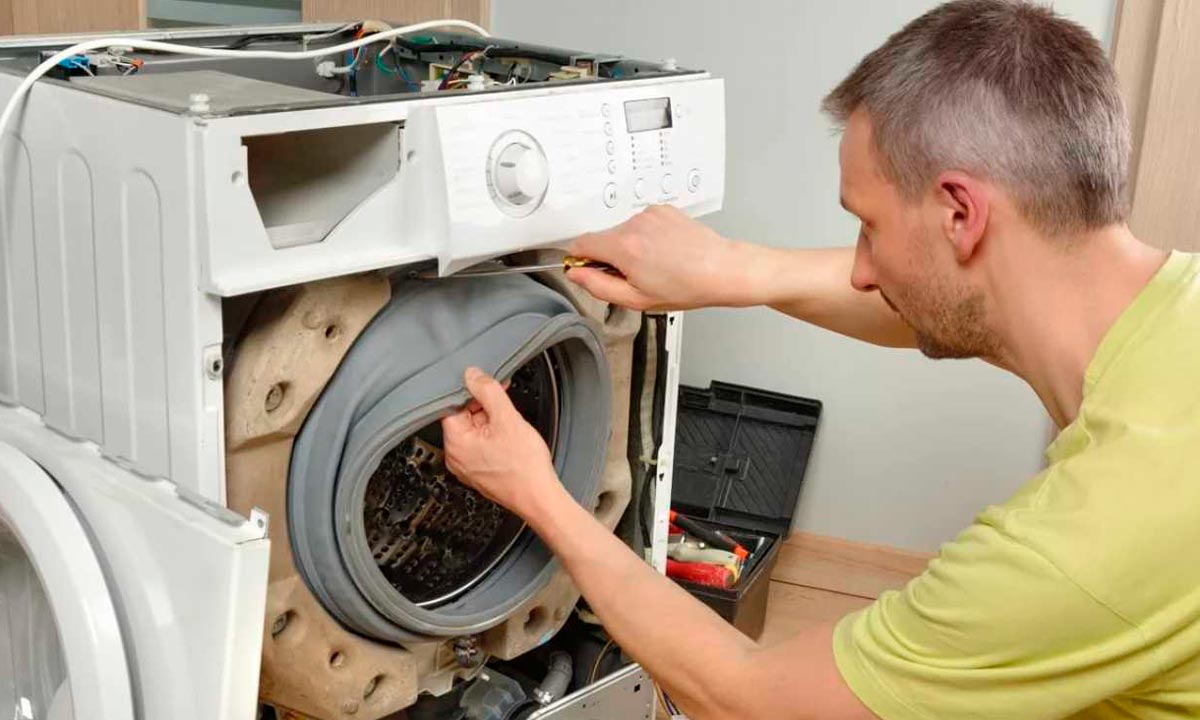Any household appliance is not eternal, and the washing machine is no exception. As a result of prolonged use or careless use, the elements of the device wear out and deteriorate, the equipment becomes unusable. In some cases it is possible to repair washing machines with your own hands. But in case of serious problems, it is better to contact Brooklyn washer machine repair at https://bestserviceappliancerepair.com.
The design of washing machines
Few owners of washing machines think about its structure and operating principles. However, in order to independently repair a faulty washing machine at home, you need to know its internal structure and the purpose of the main assemblies and parts.
Controls
The main detail in a modern washing machine is the control module. It is with the help of the control board, which is a metal substrate with many resistors, diodes and other elements, all washing processes take place: starting and stopping the machine, heating and draining the water, spinning and drying the laundry.
From special sensors, the module receives information on how to act in a particular period of time. Three sensors are used in the machine:
- Pressostat – shows the water level in the tank;
- Thermostat – determines the temperature of the water;
- Tachometer – controls the number of revolutions of the engine.
The control module is not only the most important but also the most expensive part of the washing machine. If it fails, the machine begins to “wack” or refuses to do the job at all. Without special skills in repairing electronic equipment, you should not fix the board yourself. Most often this part is completely replaced or given to professionals for repair.
Executing devices
After receiving the appropriate washing instructions from the hostess of the machine (mode, water temperature, need for an extra rinse, etc.) and after checking the status of the sensors, the control module gives the necessary orders to the executing mechanisms.
- The door of the loading hatch is blocked with a special device UBL. The machine will remain in this state until the end of washing, and only after 2-3 minutes after draining the water the control module will give a signal to unlock the door.
- Water is fed into the device tank through the valve. As soon as the pressostat shows that the tank is full, the water supply will automatically stop.
- A tubular electric heater (TEN) is responsible for heating the water. It receives a signal from the module about the time of switching on and the temperature to which it is necessary to heat water in the tank.
- The motor of the machine is responsible for the rotation of the drum, which through a belt or directly connected to the pulley of the drum. The starting and stopping torque, as well as the rotation speed is controlled by the control module.
- Drainage of waste water is carried out by means of a pump. The drain pump pumps the water out of the drum and sends it to the sewage pipe.
Such seemingly simple mechanisms under the control of the electronic module perform all the work of the washing unit.
Washing machine tank
The tank is a sealed plastic container that occupies most of the body of the washing machine. Inside the tank there is a drum for loading the laundry and the heating element.
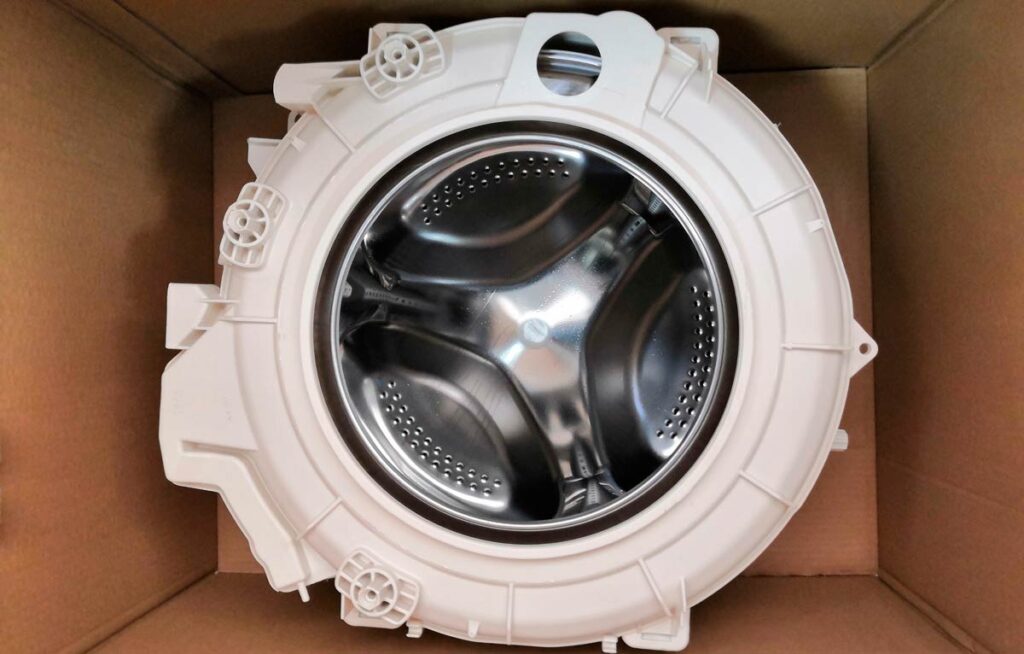
The tank of the washing machine consists of two parts connected by metal brackets or bolts. Water intake and drain occurs through special nozzles connected to the walls of the tank. To reduce the vibration that occurs during the rotation of the drum, the upper part of the tank to the machine body is attached to the springs, and the lower part – with the help of shock absorbers.
The drum is made of high quality stainless steel. By rotating in it, the laundry is washed and wrung out, completely free of dirt. The rubber sleeve, located between the tank and the drum, ensures tightness of the construction.
Problems and their elimination
Every housewife is familiar with the unpleasant situation when the washing machine broke and the laundry has to be reached by hand. In some cases, you can solve the problem yourself, without resorting to the help of professionals. Here is a list of problems, the solution of which does not require special skills.
Washing does not start
One of the common problems that occur with washing machines is when the washing cycle does not start when you press the power button. If at the same time the indicators on the control panel do not light up, it means that it is the electrical supply of the machine. It is necessary to check the socket, plug and surge protector.
In the case when the machine does not turn on, but all the indicators are blinking, you can suspect the failure of the UBL or control module. With the socket can deal with any novice master, but the replacement of the UBL or the electronic board should deal with a specialist.
Water is not coming in
In the event that the tank is not getting water, the first thing to do is to check whether there is water in the water system. After making sure that everything is normal, it is necessary to clean the supply hose and inlet filter. If the faults in the water supply nodes are excluded, then the control unit is broken.
The water is not heating
The fact that the water is not heated, you can know by touching the glass of the loading hatch. If the set washing mode has a temperature of more than +86°F, and the glass is still cold, then there is a problem.
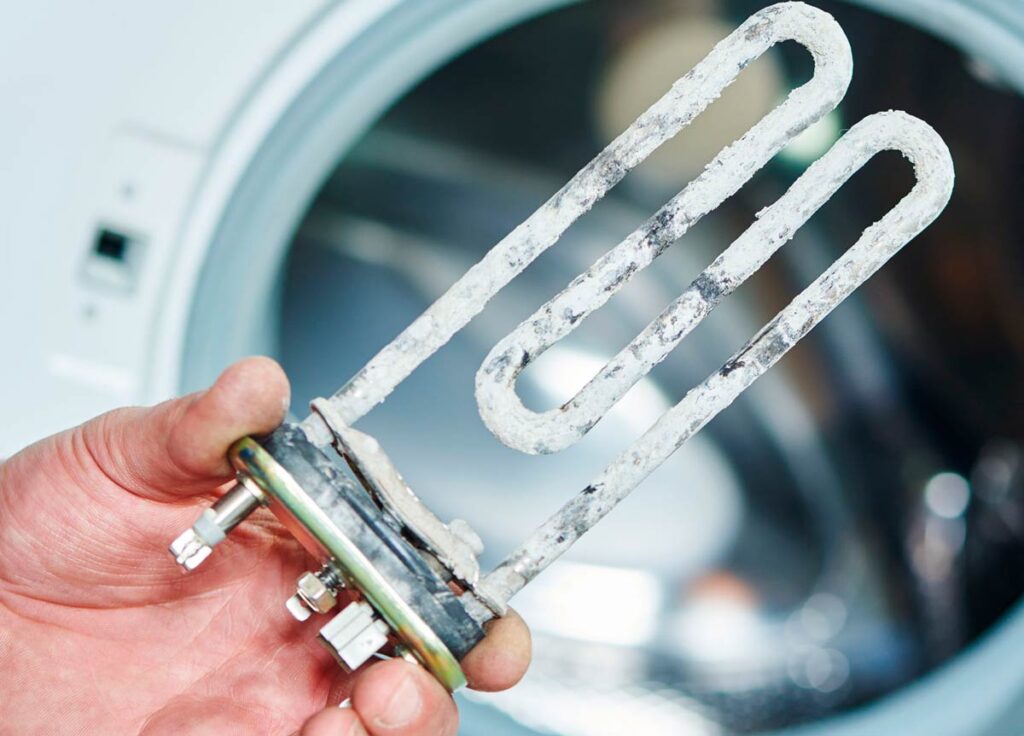
There are several reasons for the malfunction:
- The heating element burned out;
- The thermostat malfunctioned;
- Program error.
Heating element and thermostat are consumables, which need to be replaced from time to time. In order to eliminate the error in the control module, it is necessary to restart the program. If the problem persists, the software device will have to be changed.
The drum does not rotate
Another unpleasant situation – the machine works, but the drum does not spin. In this situation, the following problems are suspected:
- The drive belt has torn or come off – the drum rotates easily by hand;
- The engine has stopped;
- There is a foreign object stuck between the drum and the tank;
- Program error.
The owner of the machine can remove the stuck object himself, but with the repair of the engine and replacement of the belt it is better to refer to a workshop.
The water is not draining
The drain pump (pump) is responsible for draining the used water. To prevent small objects left in the pockets of clothes due to absent-mindedness of the mistress from clogging the sewer pipe, the pump has a filter, which should be cleaned occasionally. If the filter is clogged or the pump is broken, the machine will not discharge dirty water. The way out of this situation is very simple – clean the filter or change the drain pump. Only an experienced technician can fix the pump.
Water leaks from the washing machine
It happens that while washing, water oozes out of the machine onto the floor. It is important to keep track of how often this happens. If such trouble happened once (for example, when washing tulle), you should use less powder. The fact is that the lightweight fabric whips up a lot of foam, which seeps into the smallest technological holes and spreads across the floor in the form of puddles.
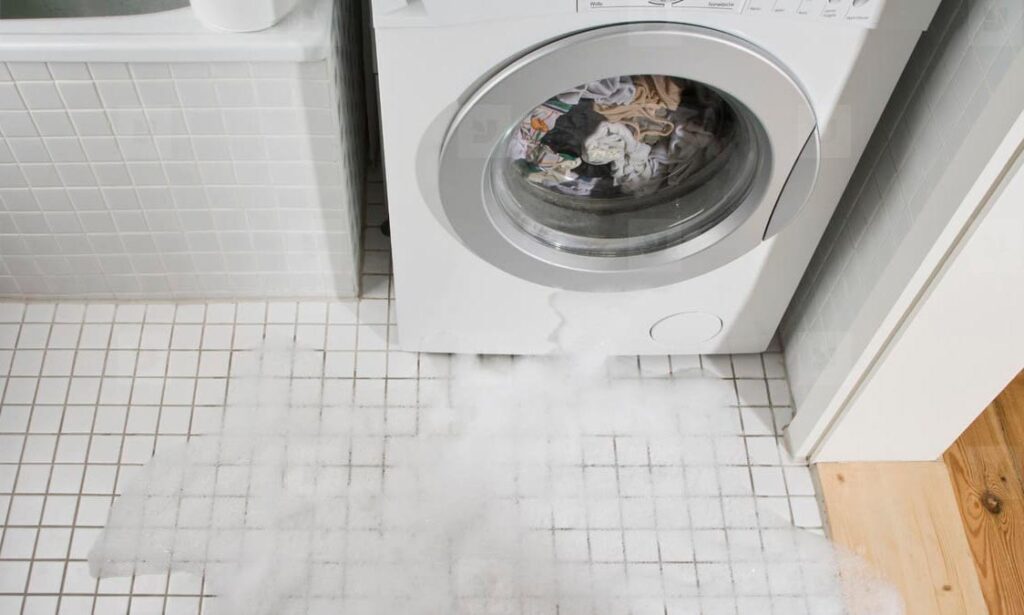
In the case where the water leaks at every wash, the causes of the malfunction are as follows:
- The gasket on the water inlet hose is cracked;
- The rubber seal on the door is torn;
- Water leaking from the water inlet hose.
Having found out exactly where the machine is leaking water, it is necessary to replace the damaged parts. With such breakdowns, it will not be difficult to repair the washing machine at home with your own hands.
The machine vibrates a lot
A modern machine is quite quiet when in working order. If the machine knocks and roars like a rocket at startup, you need to look for a malfunction.
Causes of knocking:
- Improper installation – when installing, you need to make sure that the machine stands firmly on the floor, in the same plane;
- A foreign object lodged between the tank and drum;
- Worn bearing;
- Unbalance when loading laundry;
- Failed shock absorbers.
If the cause of the malfunction is due to worn shock absorbers and bearings, the parts will have to be replaced. In other cases it is necessary to use the washing machine correctly: when loading the laundry distribute it evenly in the drum, remove foreign objects from the pockets of clothes, wash problematic items in bags.
The loading hatch does not open
Washing has finished normally, but it is not possible to open the door of the hatch. There are several reasons for the malfunction:
- The handle or door lock is broken – the worn out hardware needs to be replaced;
- The hatch locking device doesn’t work;
- The control module is out of order.
If the door lock is associated with a program error, you need to disconnect the machine from the network for a few minutes and then try to open the hatch again. If the UBL is broken, the device will have to be replaced. This can be done by yourself.
No spin
Usually the washing process ends with spinning the laundry. The machine does not discharge water and refuses to spin the laundry in the following situations:
- The washing program is set incorrectly – when washing wool, silk and other delicate materials, the spin is not provided by the manufacturer;
- Unbalanced laundry – the drum cannot rotate at high speed because the laundry is unevenly distributed inside the machine;
- The pump is broken, the machine does not discharge water, as a consequence, does not proceed to spinning;
- The tachometer may be broken;
- Problems with the motor, such as worn brushes.
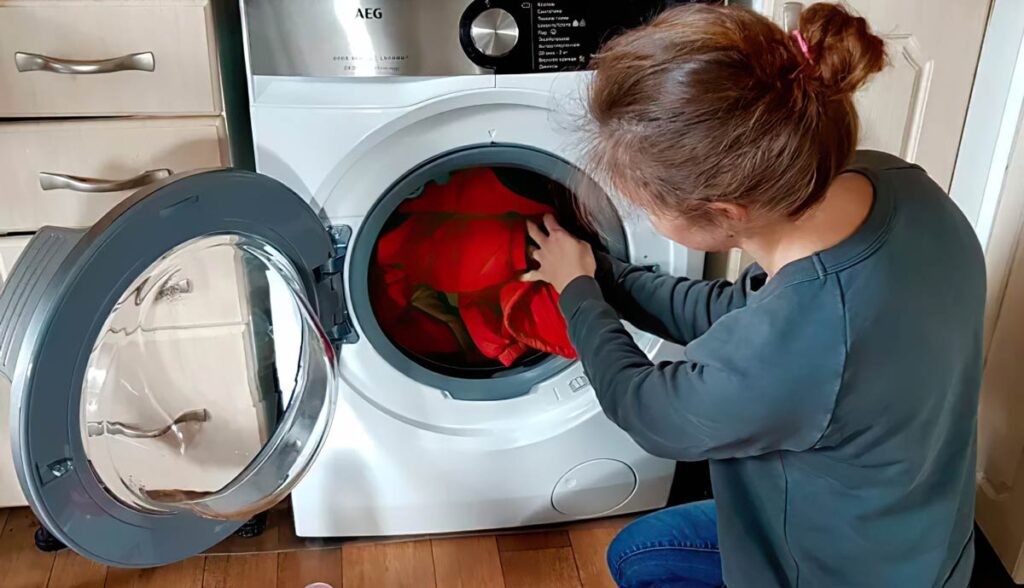
In any of these cases, you must first disconnect the appliance from the mains, remove water from the tank through the drainage hole in the pump, unlock the door and only after that look for the cause of the failure.
Electrocution
The washing machine is an electrical appliance that needs to be grounded when installed. If the case is electrocuted, it means that the electrical wiring is faulty. The cause of the malfunction can be a break in the wires inside the machine, a breakdown of the heating element or the motor. In any case, it is necessary to urgently find the place of electrical leakage and fix the problem, otherwise it is not safe to use the appliance.
Repair
Repair of faults of washing machines requires skills to work with tools and at least a minimal knowledge of the device of electronic equipment. The approximate work plan below will allow you to avoid unfortunate mistakes and eliminate the problem with your own hands.
Washing machine pumps
To repair a broken drain pump, even professionals take it very rarely. This device is not too expensive, it is easier to replace the whole. The main thing is to find a part of the right brand in the store.
Replacement of the pump is carried out as follows.
- Remove the bottom panel.
- Using a screwdriver, disconnect the pump from the body of the machine.
- Pressing from the outside on the drain valve, push the pump inside the housing and take it out.
- Disconnect all wires to the pump.
- Remove the drain hose and nozzle.
- Install the new device.
After that, it is necessary to assemble the washing machine, performing all actions in reverse order, put it in the working position and check the work of the new part by turning on the washing without laundry.
The control module of the washing machine
In many models, the control board is located at the top of the front of the machine, it is not difficult to remove it. Having freed the substrate with the microchip from the fixing strips, it is necessary to examine it carefully. Signs of the need for repair are as follows:
- The plate has changed color in some places, the tracks are darkened;
- Torn condenser caps;
- Darkened head processor mounting location.
Having detected one of these defects, it is better to apply to a workshop right away. After all, to fix the chip will require both the appropriate skills and the ability to work with a soldering iron.
Bearing replacement
If the washing machine began to spin loudly, then one of the causes may be a damaged bearing. To change the bearings in a machine with vertical load, it is necessary:
- Disassemble the body of the appliance, remove the back wall.
- Remove the belt from the pulley, freeing access to the bearing system.
- Unscrew the central bolt securing the pulley to the drum, and remove the pulley.
- Remove the three screws securing the structure and remove the coupling and bearings.
- Remove the o-ring and packing from the shaft, which will also have to be replaced.
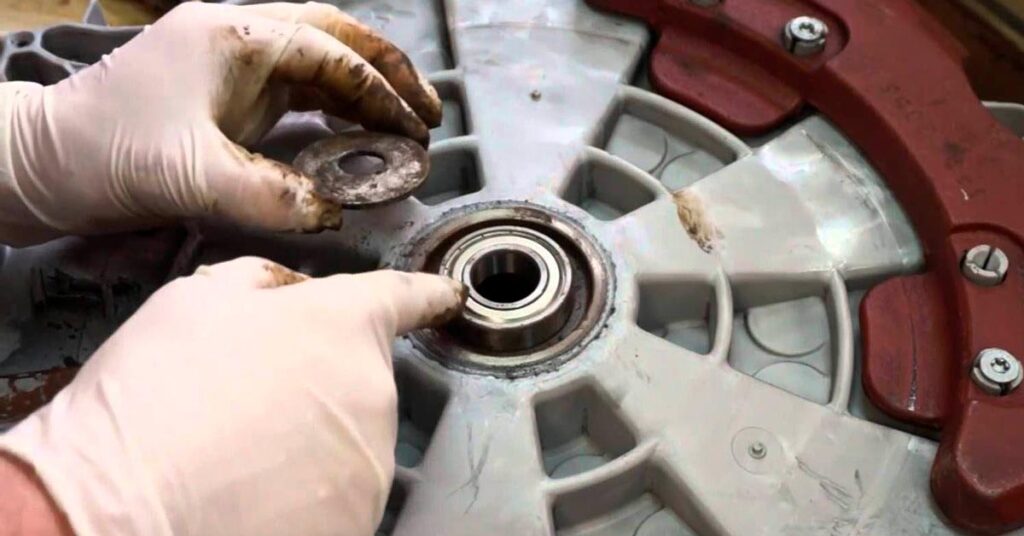
Then it remains only to install the new parts and assemble the washing machine, performing the work in reverse order.
Heating element replacement
The heating element often needs to be replaced. It can burn out from long use or unstable voltage in the electric network. From constant contact with water, the tubes of the heating device are covered with limescale.
It is not difficult to change the heating element, you just need to do the following steps:
- Remove the back panel, as most often the heating element is located in the back of the case.
- Disconnect the connection terminals of the electric appliance.
- To pull out the faulty heating element, unscrew the nut with a wrench and press the pin with a screwdriver. Using unscrewing movements take out the damaged part from the gasket.
- Install the new part, taking care not to deform the seal.
- Insert the pin, tighten the nut, connect the wires.
Having photographed the position of parts and wires before disassembly, you can greatly facilitate your work.
Shock absorbers and dampers
Shock absorbers and dampers protect the components of the washing machine from vibration and premature failure. However, these elements themselves wear out quickly and often need to be replaced.
In the dampers it is enough to change the seals. Replacing the shock absorbers is a complicated job that requires complete disassembly of the washing machine body. With this problem it is better to contact the service center.

